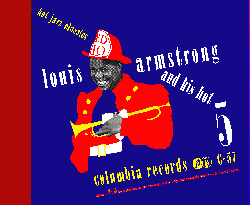
 |
Louis Armstrong & his Hot Five |
 NOTE: This Album Art .gif is from a 1940s reissue album of sides that were originally recorded in 1927. The graphic artist was Mr. Alex Steinweiss of Sarasota, Florida, who has his trademark script signature displayed in the upper right hand corner of the original album. Mr. Steinweiss worked as Art Director for Columbia Records from 1939 on, and designed over 2000 78 and LP album covers, many of which it turns out, are in the WAMS library. The below listed information is right off the inside cover of this four record Columbia album, C-57.
NOTE: This Album Art .gif is from a 1940s reissue album of sides that were originally recorded in 1927. The graphic artist was Mr. Alex Steinweiss of Sarasota, Florida, who has his trademark script signature displayed in the upper right hand corner of the original album. Mr. Steinweiss worked as Art Director for Columbia Records from 1939 on, and designed over 2000 78 and LP album covers, many of which it turns out, are in the WAMS library. The below listed information is right off the inside cover of this four record Columbia album, C-57.
The logical terminus for the New Orleans musicians was Chicago. There they found a wide-open town, with speakeasies which required "peppy music" along with Prohibition gin. As a result, Chicago musicians* came into contact with and assimilated New Orleans music. While in Chicago, the New Orleans musicians made the records which are the sole preservation of New Orleans jazz.
Certainly the most influential of these New Orleans men was Louis Armstrong. Considered by most critics to be the greatest single figure in jazz, Louis was also one of the most proliftc recording artists of the twenties.
Armstrong's early Okeh records are perhaps the most important he ever made - and the best. After recording with King Oliver's Jazz Band and Clarence Williams' Blue Five, Louis organized his own group - the Hot Five. The Armstrong Hot Five records are typically New Orleans: cornet, trombone. clarinet improvisations over a bedrock rhythm provided by piano and banjo.
This band never existed outside of the recording studio. Louis picked the best musicians he knew for these discs. Three of them had been his colleagues in the old King Oliver band: Johnny Dodds, whose clear-toned, limpid clarinet wove in and out of the ensembles and shared solo honors with Louis' cornet; Johnny (Buddy) St. Cyr, one of the greatest rhythm men of all time; and pianist Lil Hardin, whom Louis married in 1924, and whose ideas were an indispensable part of the Hot Five's recording sessions. To provide the solid foundation demanded by a New Orleans ensemble, Louis sent "back home" for Edward (Kid) Ory, recognized king of tailgate trombonists.
And of course there was Louis himself, playing the intense, driving lead cornet, which is simply the best.
"Gutbucket Blues" is an ideal first side for this album. After Louis' highly pertinent opening comment (quoted above), the band plays two ensemble choruses, a series of solos, and a closing ensemble - which just about sums up the Hot Five. The only thing missing is a stoptime chorus by Louis. "Oriental Strut" and the celebrated "Cornet Chop Suey" cover this phase of Armstrong most satisfactorily. A variation of this idea appears in the first chorus of "Yes! I'm In The Barrel," which also contains one of the finest clarinet solos on wax - two choruses in a row by Johnny Dodds.
The exuberant ensembles on these records are, in themselves, definitions of New Orleans style. "Muskrat Ramble" and "My Heart" are perhaps the most noteworthy from this point of view. "You're Next" (which is the source of Jack Teagarden's magnificent "Makin' Friends" in the Columbia C-46 "Hot Trombones" album) and "Skid-Dat-De-Dat" present Louis and the band in a sober, intense mood.
![]()
* Notably the Austin High School Gang of Columbia's C-40 "Comes Jazz" and C-43 "Frank Teschemacher" albums.
![]()
Return to the W.A.M.S. Home Page